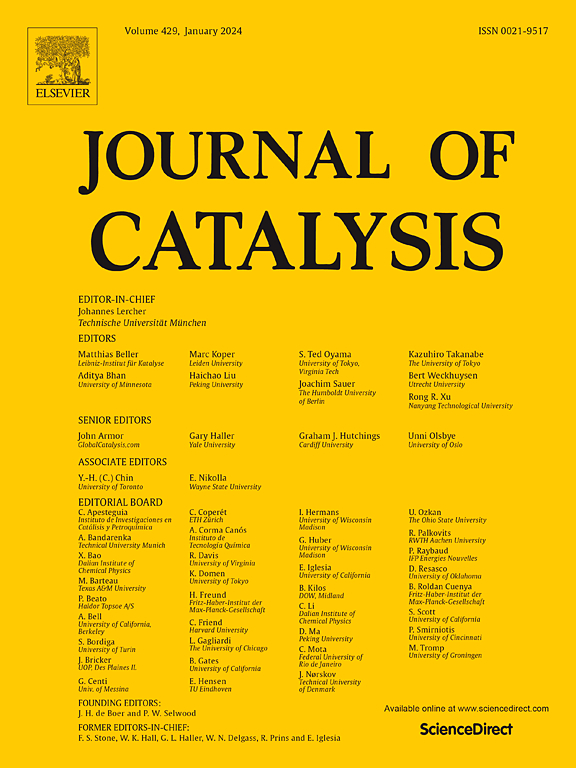Surface modification of SiO2 support with N-containing polymer for enantioselective hydrogenation over Pt catalyst
IF 6.5
1区 化学
Q2 CHEMISTRY, PHYSICAL
引用次数: 0
Abstract
The design of highly enantioselective heterogeneous catalysts offers an efficient route for the production of enantiopure chiral molecules, which are crucial intermediates in the pharmaceutical, agrochemical, and fine chemical industries. In this study, we present a strategy to enhance the enantioselectivity of supported Pt catalysts for the hydrogenation of α-keto esters by modifying SiO2 supports with poly(ethyleneimine) (PEI), a nitrogen-rich polymer. By adjusting the heat-treatment time, the quantity of PEI-derived residues on the support was successfully controlled, thereby fine-tuning the electronic state of Pt through electron-transfer interactions, and resulting in the generation of positively charged Pt species. Catalytic evaluations showed that the Pt/PEI-SiO2 catalysts exhibited superior enantioselectivities compared to the unmodified Pt/SiO2, with an optimal performance of 96.1% enantiomeric excess (ee). In addition, the Pt/PEI-SiO2 catalysts exhibited high enantioselectivities using various α-keto esters, chiral modifiers, and H2 pressures, as well as an excellent reusability over ten consecutive cycles. The observed correlation between the higher proportion of positively charged Pt species and the increased ee suggests that the improved enantioselectivity of the Pt/PEI-SiO2 catalyst system is driven by the enhanced adsorption of chiral modifiers, which is facilitated by interactions between the anchoring moiety and the electron-deficient Pt surface. These findings highlight the essential role of interactions between the active metals and the modifying organic species bound to support materials in enhancing the enantioselectivity. Moreover, they provide valuable insights for catalyst design through electronic tuning of the active metal surface with organic-modified supports.

含n聚合物对Pt催化剂对映选择性加氢SiO2载体的表面改性研究
高对映选择性非均相催化剂的设计为生产对映纯手性分子提供了有效途径,这些分子是制药、农化和精细化工行业的重要中间体。在这项研究中,我们提出了一种策略,通过用富氮聚合物聚(乙亚胺)(PEI)修饰SiO2载体来提高负载Pt催化剂对α-酮酯加氢的对映选择性。通过调整热处理时间,成功控制了载体上pei衍生残基的数量,从而通过电子转移相互作用对Pt的电子态进行微调,从而产生带正电的Pt物质。催化评价表明,Pt/PEI-SiO2催化剂的对映体选择性优于未改性Pt/SiO2催化剂,其对映体过量(ee)达到96.1%。此外,Pt/PEI-SiO2催化剂在不同α-酮酯、手性改性剂和H2压力下均表现出较高的对映选择性,并且在连续10次循环中具有良好的可重复使用性。结果表明,Pt/PEI-SiO2催化剂体系对映体选择性的提高是由于锚定部分与缺电子Pt表面的相互作用促进了手性修饰剂的增强吸附。这些发现强调了活性金属与支持材料的修饰有机物质之间的相互作用在提高对映体选择性方面的重要作用。此外,它们通过电子调谐有机修饰支撑的活性金属表面,为催化剂设计提供了有价值的见解。
本文章由计算机程序翻译,如有差异,请以英文原文为准。
求助全文
约1分钟内获得全文
求助全文
来源期刊

Journal of Catalysis
工程技术-工程:化工
CiteScore
12.30
自引率
5.50%
发文量
447
审稿时长
31 days
期刊介绍:
The Journal of Catalysis publishes scholarly articles on both heterogeneous and homogeneous catalysis, covering a wide range of chemical transformations. These include various types of catalysis, such as those mediated by photons, plasmons, and electrons. The focus of the studies is to understand the relationship between catalytic function and the underlying chemical properties of surfaces and metal complexes.
The articles in the journal offer innovative concepts and explore the synthesis and kinetics of inorganic solids and homogeneous complexes. Furthermore, they discuss spectroscopic techniques for characterizing catalysts, investigate the interaction of probes and reacting species with catalysts, and employ theoretical methods.
The research presented in the journal should have direct relevance to the field of catalytic processes, addressing either fundamental aspects or applications of catalysis.
 求助内容:
求助内容: 应助结果提醒方式:
应助结果提醒方式:


